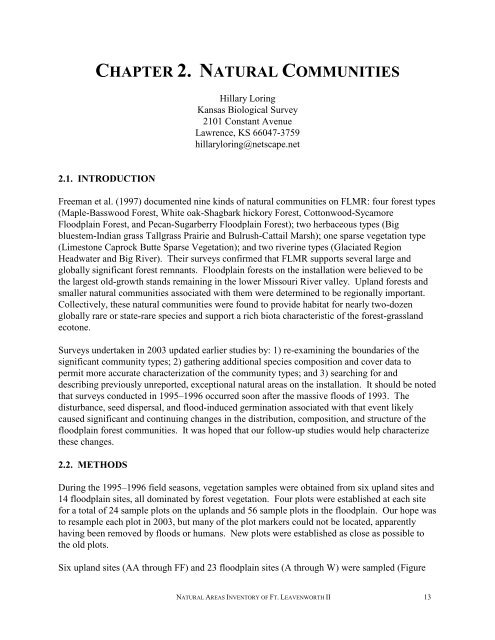A Natural Areas Inventory of the - Kansas Natural Heritage Inventory ...
A Natural Areas Inventory of the - Kansas Natural Heritage Inventory ...
A Natural Areas Inventory of the - Kansas Natural Heritage Inventory ...
You also want an ePaper? Increase the reach of your titles
YUMPU automatically turns print PDFs into web optimized ePapers that Google loves.
CHAPTER 2. NATURAL COMMUNITIES<br />
2.1. INTRODUCTION<br />
Hillary Loring<br />
<strong>Kansas</strong> Biological Survey<br />
2101 Constant Avenue<br />
Lawrence, KS 66047-3759<br />
hillaryloring@netscape.net<br />
Freeman et al. (1997) documented nine kinds <strong>of</strong> natural communities on FLMR: four forest types<br />
(Maple-Basswood Forest, White oak-Shagbark hickory Forest, Cottonwood-Sycamore<br />
Floodplain Forest, and Pecan-Sugarberry Floodplain Forest); two herbaceous types (Big<br />
bluestem-Indian grass Tallgrass Prairie and Bulrush-Cattail Marsh); one sparse vegetation type<br />
(Limestone Caprock Butte Sparse Vegetation); and two riverine types (Glaciated Region<br />
Headwater and Big River). Their surveys confirmed that FLMR supports several large and<br />
globally significant forest remnants. Floodplain forests on <strong>the</strong> installation were believed to be<br />
<strong>the</strong> largest old-growth stands remaining in <strong>the</strong> lower Missouri River valley. Upland forests and<br />
smaller natural communities associated with <strong>the</strong>m were determined to be regionally important.<br />
Collectively, <strong>the</strong>se natural communities were found to provide habitat for nearly two-dozen<br />
globally rare or state-rare species and support a rich biota characteristic <strong>of</strong> <strong>the</strong> forest-grassland<br />
ecotone.<br />
Surveys undertaken in 2003 updated earlier studies by: 1) re-examining <strong>the</strong> boundaries <strong>of</strong> <strong>the</strong><br />
significant community types; 2) ga<strong>the</strong>ring additional species composition and cover data to<br />
permit more accurate characterization <strong>of</strong> <strong>the</strong> community types; and 3) searching for and<br />
describing previously unreported, exceptional natural areas on <strong>the</strong> installation. It should be noted<br />
that surveys conducted in 1995–1996 occurred soon after <strong>the</strong> massive floods <strong>of</strong> 1993. The<br />
disturbance, seed dispersal, and flood-induced germination associated with that event likely<br />
caused significant and continuing changes in <strong>the</strong> distribution, composition, and structure <strong>of</strong> <strong>the</strong><br />
floodplain forest communities. It was hoped that our follow-up studies would help characterize<br />
<strong>the</strong>se changes.<br />
2.2. METHODS<br />
During <strong>the</strong> 1995–1996 field seasons, vegetation samples were obtained from six upland sites and<br />
14 floodplain sites, all dominated by forest vegetation. Four plots were established at each site<br />
for a total <strong>of</strong> 24 sample plots on <strong>the</strong> uplands and 56 sample plots in <strong>the</strong> floodplain. Our hope was<br />
to resample each plot in 2003, but many <strong>of</strong> <strong>the</strong> plot markers could not be located, apparently<br />
having been removed by floods or humans. New plots were established as close as possible to<br />
<strong>the</strong> old plots.<br />
Six upland sites (AA through FF) and 23 floodplain sites (A through W) were sampled (Figure<br />
NATURAL AREAS INVENTORY OF FT. LEAVENWORTH II 13


